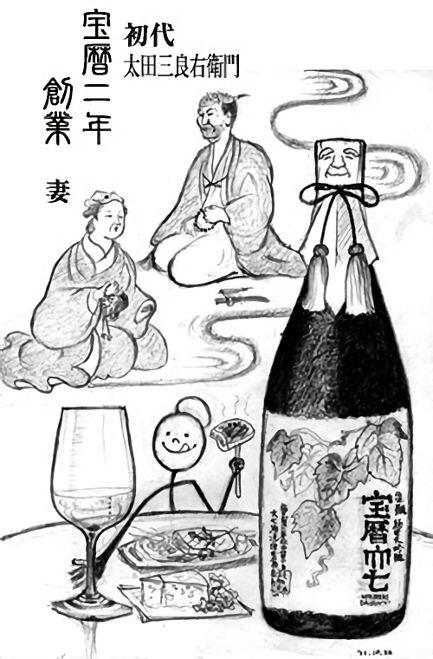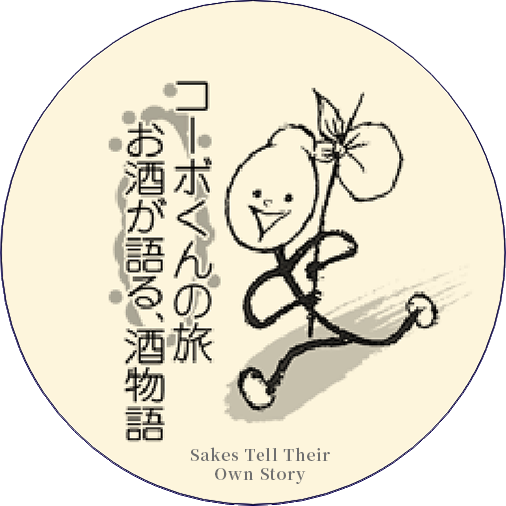| Yeast |
“Today I’m going to listen to Horeki Daishichi. For me, he is something like a ‘living legend,’ so I’m rather nervous. Hello!” |
| Horeki Daishichi |
“Ah, hello.” |
| Yeast |
“Before the start of the present century, you used to be the highest pinnacle of Daishichi. I’ve heard that the brewers always felt rather tense and in a serious mood when brewing you.” |
| Horeki Daishichi |
“In fact, I was talked about long before my actual birth. I was everyone’s dream.” |
| Yeast |
“Our great master brewer of two generations back, Katsuji Ito, used to say that a kimoto sake that was also a junmai daiginjo and a free run drops undiluted sake would be peerless.” |
| Horeki Daishichi |
“Satisfying only the form is easy, the problem is the content. Mr Ito spent many years doing research into what sake that should be.” |
|
 |
| Yeast |
“It had to be a sake that didn’t exist yet.” |
| Horeki Daishichi |
“After five long years and a tremendous amount of trials, I was finally born in the first year of Heisei, 1989. I was the pinnacle reached by Mr Ito in his last years.” |
| Yeast |
“He perfected his style, which was also a typical kimoto style!” |
| Horeki Daishichi |
“The sophisticated brilliance typical for daiginjo sake and a satisfying, strong taste must both be present together. As one specialist admired: a true ‘King of Sake.’” |
| Yeast |
“The name Horeki goes back to the name of the era in which Daishichi was founded.” |
| Horeki Daishichi |
“Yes, I consider that as a great honor and do my best to be worthy of the name.” |
| Yeast |
“As the weather and the quality of the rice vary each year, it must be difficult to maintain such a high level.” |
| Horeki Daishichi |
“We therefore put in an extraordinary effort. I am brewed at a very low temperature in a small tank, which takes a lot of time. But it is only part of me that qualifies to be sold as Horeki at the stage of the free run drops pressing. Because we want to maintain the highest level, the number of bottles obtained varies year by year. There even was a year when only 158 bottles were produced.” |
| Yeast |
“Really? Those must have been terribly precious! The design of ivy leaves on the Horeki bottle is also found in the sculptural relief that graces the Daishichi brewery, as well as in the pewter emblem on the Myoka Rangyoku bottle. That shows how proud we are of you!” |
| Horeki Daishichi |
“Thank you. The technical skills were transmitted to Masakichi Kindaichi, and the present master brewer, Takanobu Sato. I was further improved by the super-flat rice polishing technique. Thanks to Mr Sato, I became the first junmai sake brewed by the traditional kimoto method to win the Gold Medal at the Japan Sake Awards.” |
| Yeast |
“Great! But after winning a second time gold, Daishichi left the Japan Sake Awards.” |
| Horeki Daishichi |
“Yes, because we are aiming much higher than just the Japan Sake Awards – our dream is limitless.” |
| Yeast |
“I’ve a final request… could I just take a small sip?” |
| Horeki Daishichi |
“Of course. Please use this daiginjo glass made by Riedel.” |
| Yeast |
“It’s impressive that from among scores of glasses, this one was selected as the best glass for daiginjo and that the final tasting took place with you, Horeki.” |
| …Swirls the glass and takes a sip… |
| Yeast |
“Mmm. A rich fragrance and a concentrated taste. Strong and pure. Though mellow, it’s also scintillating.” |
| Horeki Daishichi |
“As food goes, I want you to combine me with a strong main dish. I also fit well to blue cheeses such as Roquefort.” |
| Yeast |
“You’re really unique and different from any other sake!” |
| Horeki Daishichi |
“I’m happy to hear that. And that’s how I want to keep it!” |





